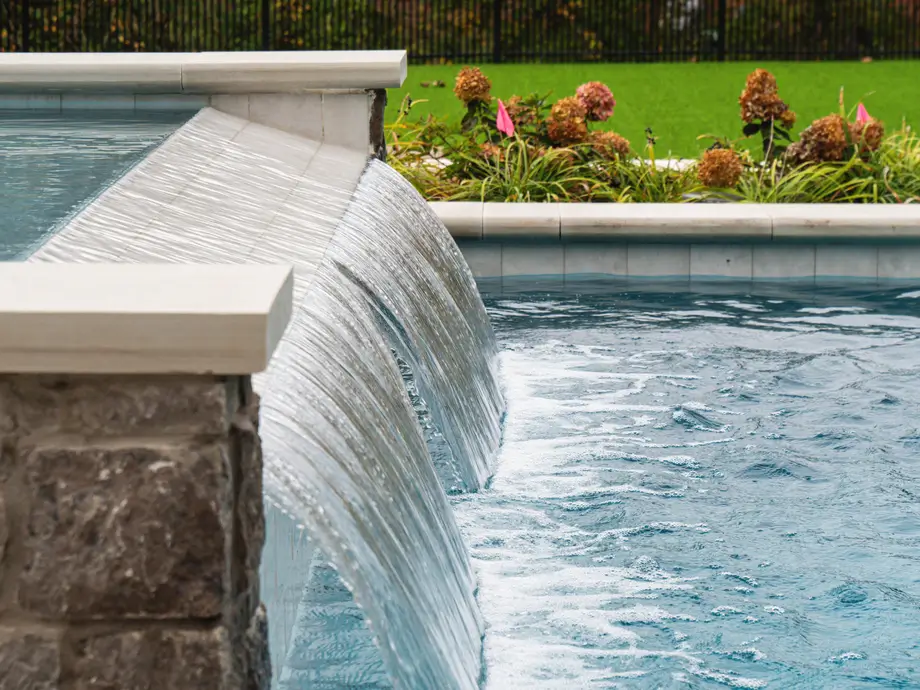Considering a new pool or need pool maintenance? If you’re a beginner to pool maintenance, you absolutely need to know what’s involved in caring for your pool to avoid premature wear and tear.
But where do you start? And, what do you need to address first?
If you want to ensure that your pool is clean, healthy, and well-maintained, keep reading.
Good Day Living here: we’ve been building world-class fiberglass and gunite swimming pools and helping homeowners navigate the ins and outs of their backyard pool for more than two decades.
We’ll show you what you need to know to keep your pool clean and safe.
In this article on pool maintenance for beginners, we’ll discuss:
- The three most essential elements needed for proper pool maintenance
- A detailed dive into water circulation, cleaning, and chemistry
- A few key facts about pool maintenance
- Reaching out to a pool builder and pool maintenance team for your next pool project
3 Key elements of proper pool maintenance

| 1. Water circulation 2. Water cleaning 3. Water chemistry |
1. Water circulation

Proper pool maintenance starts with pool circulation.The reason is that if your pool water doesn’t circulate, if your filter isn’t functioning properly, or if your pump isn’t working, you’ll struggle to keep your pool water clean.
Stagnant water is fertile territory for algae growth. As such, familiarizing yourself with your pool’s circulation system is key in helping you keep your pool clean and well-maintained.
Let’s take a look at some of the key parts of the pool’s circulatory system:
- The skimmer
- The pump
- The filter
- The jets
If any of these parts are impaired, your water quality will take a nose dive. To keep a pool well-maintained and clean, we need to understand how to keep pool water clean and circulating.
To keep pool water clean and circulating:
- First, the pool pump sucks water from the pool through the skimmer.
- Next, the water travels through the pump into the pool’s filter.
- Then, the filter cleans out the particles that make the water dirty.
- Finally, the water is pushed into the pool through the pool’s jets.
The pool pump is the hub for your pool. For example, the pump draws water through the filtration system, where it’s cleaned of dirt, debris, and hazardous material.
Once the water is clean, it flows through the pool’s jets back into the pool. And voila! You have clean pool water.
Let’s dive further into how the above-mentioned pool equipment keeps your pool clean and safe.
Use the pool pump
Run the pool pump for about eight to 12 hours a day. The more you run the filtration system, the cleaner your water will be.
The more often you run your pool pump, the less time you’ll spend scrubbing algae from pool surfaces or balancing pool water. With that being said, if you ran your filter 24 hours a day, seven days a week, you’d spend a fortune on pool cleaning.
We understand that running a pool pump 24/7 isn’t realistic, so we recommend running your pump about 10-12 hours per day. If you live in a warmer climate, consider running the pump a little longer than 10-12 hours per day. Also, you may want to invest in a variable speed pool pump because these pool pumps run at slower speeds.
Lower pump speeds mean more money and energy saved, and less noise. As a whole, a variable speed pump can help a great deal.
But, if your pump gauge is about 10 pounds or more above normal readings, you may want to backwash your filter. Let’s talk about backwashing and cleaning filters.
Backwash and clean filters
Pool owners: backwash and clean the filter gauge when it reads about 10 pounds per square inch (PSI) higher than normal. So, for example, if your pump gauge is about 10 pounds or more above the normal reading, you may need to backwash your filter.
As a note, 10-15 PSI is the standard range for a clean filter. Whether you’re using a sand, cartridge, or diatomaceous earth (DE) filter, you’ll want to clean the filter if you notice PSI readings exceeding normal ranges.
Clean the skimmer basket
As a general rule of thumb, you want to clean the skimmer basket in your pool once or twice a week. Cleaning the skimmer and pump baskets often will be key to the overall maintenance of your swimming pool.
Clogged baskets make your pool pump work harder to cycle water. As a result, clogged baskets can decrease the life span of your pool and stress the seals in your pump.
What’s more, frogs and other creepy crawleys can lodge themselves in your skimmer. You’ll want to make sure critters are removed from your skimmer before cleaning your skimmer.
We suggest that new pool owners clean their skimmers once or twice a week, depending on how often the pool is used.
To clean a skimmer basket, turn off the pool pump and empty the removable basket under the skimmer lid, and then replace the basket.
We also recommend cleaning out the pump basket on the pool pump; with that being said, you don’t need to replace the pump basket as often, since the skimmer catches most detritus.
Angle any potential pool jets
Another way to keep your pool safe and clean is by adjusting your pool jets so that they point away from your skimmer. Doing so ensures that your pool water cycles in a circle.
By pointing pool jets away from your skimmer, you can encourage pool water to rotate and thereby ensure the debris removal process — via your skimmer — is smooth and seamless.
Another benefit of angling your jets is that the bottom of the pool will also receive circulation. If any parts of the pool struggle to receive circulation — parts such as ladders, crevices, and corners of the pool — you can angle the jets in these areas as well.
2. Water cleaning

You’ll want to vacuum your pool once a week (you can use robotic pool vacuums to help). Also, you’ll want to brush and skim your pool once per day.
Since manual maintenance is part of pool ownership, we recommend creating a schedule for yourself on what needs to be done on a weekly and daily basis. When we talk about keeping the pool’s water clean, we’re talking about removing debris from the top of the pool and vacuuming the pool once a week.
Let’s explore water cleaning in greater detail.
Brush, skim, and vacuum
Part of regular pool maintenance includes scrubbing the walls with a pool brush. Pool brushes can help prevent staining, scaling, and algae from building up along steps, crevices, ladders, and below skimmers.
To add, skimming the surface of the water with a net or leaf rake can help you collect loose debris. We can’t emphasize enough the importance of regular skimming. Regular skimming will help you remove loose debris that could otherwise fall to the bottom of the pool.
Finally, if debris does fall to the bottom of the pool, vacuuming is an essential part of the solution to remove said debris. Vacuuming also helps remove debris that can decrease circulation and damage your pool.
To vacuum your pool, you can visit your local pool supply store and purchase a vacuum head, hose, and pole. Attach these items to your skimmer through a vacuum plate, and you’ll be all set to clean the water in your pool.
3. Maintain your pool’s water chemistry

We recommend testing your pool’s water chemistry one to two times per week and shocking your pool bi-weekly. Ensuring your pool’s water chemistry is balanced is a huge factor to consider when caring for your pool.
When your pool water is balanced, you’ll stand a greater chance of not having to struggle with issues like cloudy water, green water, or bacterial buildups.
As such, you’ll want to invest in a quality pool testing kit and pool test strips to keep the water in your pool clean and fresh.
Ensure the right balance of chemicals
We recommend testing your pool water weekly. Choose a test kit that will tell you if you need to add pool chemicals to maintain your water’s chemical balance.
You’ll want to make sure that your pool water stays within the following ranges for the following elements:
- pH: Around 7.5. Anything above or below this number can lead to pool maintenance issues such as equipment corrosion or algae growth.
- Calcium hardness: Around 200-400 parts per million (ppm). When calcium hardness levels are lower than the recommended levels, your pool’s plaster finish or vinyl liner can be compromised. With that being said, if your pool’s calcium hardness is higher than the recommended levels, you’ll find yourself scraping up calcium deposits along your pool.
- Alkalinity: Around 120-150 ppm. Anything below 120, and your pool’s surfaces could stain. Anything above 150 can result in cloudy pool water
- Phosphates: Phosphates can affect pH levels, contribute to algae growth, and make your pool water cloudy. Having high levels of phosphates in a pool can make maintaining pool chemistry a real challenge. Ensuring proper amounts of phosphates can help you keep your water balanced.
- Chlorine: Available in sticks, tablets, and small granules. Chlorine helps break down bacteria that can eat at your pool. Also, chlorine helps sanitize your pool so that your swimming pool’s water stays clean.
Use sanitizers as needed
Speaking of pool sanitizers, chlorine tends to be used often. But many other types of sanitizers exist.
Different ranges exist for different types of sanitizers. Let’s take a look at acceptable limits for common sanitizers:
- Chlorine sanitizer: 1-3 ppm
- Bromine sanitizer: 3-5 ppm
- Biguanide sanitizer: 30-50 ppm
- Chlorine mineral backup sanitizer: 0.5 ppm
Shock the pool
We recommend shocking your pool every one to two weeks. And, when we say shock the pool, we don’t mean you should scare the pool (boo!).
Jokes aside, to keep your water clean, you should overload your swimming pool with sanitizer to kill any bacteria, organic material, or contaminants. You literally and metaphorically neutralize and spook — or “shock” — the bacteria and contaminants out of the water.
As a general rule of thumb, the more you use your pool, the more often you should shock it. With that being said, you may also want to shock your pool after heavy use or during unusual circumstances.
Unusual circumstances that may call for more frequent shocking include:
- Post-stormy weather
- After an unexpected chemical spill or contamination in your pool
- If algae rears its ugly head
Did you know?

Did you know that we also build pools, as well as provide post pool-build maintenance? Whether you’re dreaming of weekend swims, backyard parties, or just a peaceful place to float, we build pools that feel like a weekend getaway without leaving home.
Let’s bring your vision to life. Contact us or start planning your custom pool today.
Need some inspiration for your new pool build? Check out our gallery of stunning pool finishes and custom home builds here.
Thinking about a new pool or pool maintenance?

As the need for pool services grows, the market is quickly shifting to meet it. More and more people are relying on pool maintenance and equipment to keep their pools clean and safe, according to an Arizton report (2017).
Given the growing market for pool maintenance, we want you to make sure you’re making the most of your pool maintenance routine.
With that said, the last tip we have for you to maximize your pool maintenance efforts is to keep a consistent maintenance schedule and pool maintenance routine. Daily and weekly maintenance is key for keeping your pool sparkling clean.
But, if you still have questions — and your local pool supply store didn’t provide the support you needed — give our professional pool pros a call. We can help you with everything from building your new pool to conducting seasonal maintenance on it.
Whether you’re considering building a new swimming pool or just need help with the basics of pool cleaning, get in touch with our seasoned pool technicians. They’d be happy to walk you through your options and answer any questions you may have.
Until then, we hope this guide helped you, and we look forward to hearing from you as to how we can be of service.
